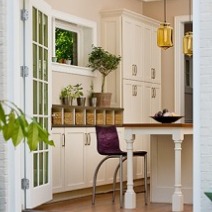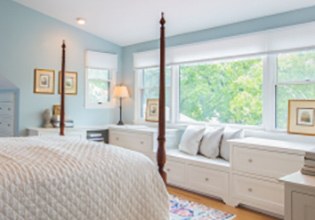Blending Italianate & Modern in a DC Home Renovation
“Adding Space Creatively on Capitol Hill” – From House to Home, Chapter Two, Part Two
A Transitional Kitchen
As the only part of the old house included in the project, the kitchen played a vital transitional role, forming a visual and physical bridge from old to new. My clients considered its size perfectly adequate for their needs, especially since their sons were now grown and out of the house. But the room was dated, dark and poorly laid out, requiring a complete remodel.
One obvious issue was the small, 2-foot wide kitchen window. Replacing it with a dramatically larger 5-foot wide window, topped by a pair of awning windows, immediately began to transform the space. The second step was removing most of the old exterior wall between it and the new addition. This open-plan arrangement allowed room for an island – still located within the kitchen, but made usable by the increased space around it. Within this setting, Shari Daniels specified a mix of old and new materials – cherry for the base cabinets and island, painted wall cabinets, honed granite countertops, a marmoleum floor and stainless steel appliances echoed by custom stainless steel legs at one end of the island. Glass pendants hung over the island. In a modern touch, the backsplash of mosaic stone tiles wrapped around the jamb of the new window, avoiding traditional trim and highlighting the home’s landscaping, particularly the garden.
Modern Italianate Architecture: A Good Blend
The centerpiece of the project, of course, would be the new family room, also called the garden room, which not only filled in the old dogleg layout but extended several feet farther into the backyard. The view from this room would be unusually panoramic. At 25 feet by 100 feet, my clients’ garden was a large one for the city. But the angle of the view was even wider. The lack of a wall or fence on one side allowed a view of the neighbor’s garden, and there was only a 4-foot wire fence on the other side.
In response to this wide vista, I suggested wrapping a wall of windows around the back corner of the new room. By providing a range of viewing angles, the wraparound windows made the house feel more like a detached home than an urban rowhouse, where elements are often strictly lined up on a front-to-back axis. As in the kitchen, awning windows were placed above the large windows. Now that both sides of the townhouse would be anchored to the adjoining walls, the awning windows in the family room and kitchen would play an important part as the only source of fresh air at this end of the townhouse, at least on the first floor.
Architecturally, the large expanse of glass suggested a contemporary style for the addition, which served as a nice contrast to the Italianate house. One reason the two styles worked well together is that the rear walls of older townhouses tend to be almost featureless; many elements that make a townhouse Italianate are only seen at the front. Using brick for the new room also helped unify it with the house, which was stucco over brick. Using similar windows in both the new room and the kitchen had the same effect.
Although the windows brought in a wealth of natural light, I added still more light with a pair of skylights in the high ceiling. Shari Daniels complemented these with lighting fixtures in diverse styles and locations: a modern wall sconce, floor lamps and an antique Venetian glass chandelier that worked well with the skylights.
To read more about this project, download our remodeling eBook!








